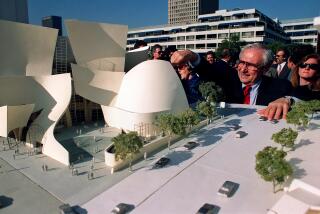MUSIC REVIEW : Memorable salute to Henry Purcell : The Philharmonia Baroque Orchestra enthralls with his ‘Dido and Aeneas.’
Amid the flurry of round-numbered commemorations this year, Henry Purcell -- born 350 years ago -- finally had his day in the Walt Disney Concert Hall on Wednesday night.
Nicholas McGegan, the jolly elf of the period performance scene, brought his crack Philharmonia Baroque Orchestra and Chorale down from the Bay Area as part of a West Coast tour.
He also brought the tall, Texas-raised star mezzo-soprano Susan Graham for her Disney Hall debut and a first-class cast of singers. The ingredients for a memorable concert performance of Purcell’s compact opera “Dido and Aeneas” were in place -- and they didn’t let us down.
Purcell puts his audience through the emotional wringer with concisely sketched, bewilderingly swift shifts of mood -- and McGegan would not shy away from these extremes. The instrumental dances could scarcely have been more lively in feeling or more rhythmically well-sprung. The silly scenes with the Sorceress (contralto Jill Grove) and her witches couldn’t have been sillier; McGegan even got his flexible chorus to sing with a cackle in its collective tone. All the fun that he and his crew were having made the transition to pathos in Act III even more jolting.
Dido’s famous aria, “When I Am Laid in Earth,” was taken as slowly as one would dare, with Graham melting everyone in sight with a golden mellow timbre and a heartbreaking interpretation of Purcell’s descending intervals on the word “trouble.”
Seated on the stage’s sole prop, a throne, Graham was very much the passionate yet imperious queen, flanked by the lusciously agile soprano of Cyndia Sieden -- who quickly converted back and forth from sensible Belinda to one of those nutty witches -- and Celine Ricci’s slightly harder-edged 2nd Woman.
No two “Didos” are alike, and this one had its variants: instrumental postludes to Acts II and III, the virile-voiced baritone William Berger as Aeneas (sometimes a tenor is used).
As an extended prologue to “Dido,” McGegan took us through a Purcell sampler that piled on the Benjamin Britten references -- such as the suite from “Abdelazer,” whose Rondeau was turned by Britten into the symphonic tour-de-force “The Young Person’s Guide to the Orchestra” and the Chacony in G minor, which Britten lushly orchestrated. McGegan, of course, stuck with the originals, imparting all kinds of inflections with a flick of his fingers -- and showed off his precise, clear chorus in the cantata “O Sing Unto the Lord a New Song” and the short anthem “Hear My Prayer, O Lord.”
--
More to Read
The biggest entertainment stories
Get our big stories about Hollywood, film, television, music, arts, culture and more right in your inbox as soon as they publish.
You may occasionally receive promotional content from the Los Angeles Times.










